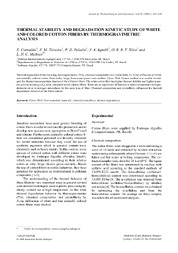Thermal stability and degradation kinetic study of white and colored cotton fibers by thermogravimetric analysis.
Thermal stability and degradation kinetic study of white and colored cotton fibers by thermogravimetric analysis.
Author(s): CORRADINI, E.; TEIXEIRA, E. M.; PALADIN, P. D.; AGNELLI, J. A.; SILVA, O. R. R. F.; MATTOSO, L. H. C.
Summary: Brazilian researchers have used genetic breeding of cotton fibers in order to increase the production and to develop new species more appropriate to Brazil’s soil and climate. Furthermore, naturally colored cotton fibers are considered potential eco-friendly materials for textile industries because they avoid the use of synthetic pigments which in general, contain toxic chemicals such as heavy metals. In this context, some species of colored cotton with different colors were developed by Embrapa Algodo (Paraíba, Brazil), which was denominated according to their relative colors as: ruby, beige, brown, green and ruby. Beside the use of cotton fibers in textile industries, they have potential for application as reinforcement to polymer composites [1–3].
Publication year: 2009
Types of publication: Offprints
Unit: Embrapa Cotton
Observation
Some of Embrapa's publications are published as ePub files. To read them, use or download one of the following free software options to your computer or mobile device. Android: Google Play Books; IOS: iBooks; Windows and Linux: Calibre.
Access other publications
Access the Agricultural Research Database (BDPA) to consult Embrapa's full library collection and records.
Visit Embrapa Bookstore to purchase books and other publications sold by Embrapa.

